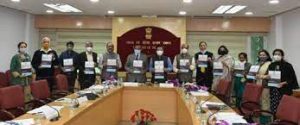National Family Health Survey (NFHS 2019-21) Released:

The latest data from the National Family Health Survey (NFHS 2019-21) has been released.
Prevalence of Child Marriage:
- The share of women aged 20-24 who married before turning 18 has declined from 27% to 23% in the last five years.
- West Bengal and Bihar, with around 41% such women each, had the highest prevalence of girl child marriage.
- The maximum reduction in the proportion of underage marriages was observed in Rajasthan, Madhya Pradesh, and Haryana.
Rampant Anaemia:
- As many as 57% women aged 15-49 were anaemic in 2019-21, compared to 53% in 2015-16, while the same for men rose from 22.7% to 25%.
- The most formidable increase—8.5% was observed for children aged 6-59 months (67.1%).
- Among larger states, West Bengal and Kerala reported the highest and lowest prevalence, respectively, of anaemic women.
- Child anaemia rates worsened the most in Assam, Mizoram, Chhattisgarh, and Odisha.
Improving Amenities:
- All states, except Manipur, Meghalaya, Assam and Jharkhand, had over 90% population with access to improved drinking water sources.
- Bihar, Jharkhand etc states had almost doubled the access since 2015-16, but most fell below the 75% mark.
Women who own House:
- The number of women who own a house or land in Delhi, either alone or jointly, has significantly dipped over the past five years.
- While the percentage of women who had a house or land registered in their name in 2015-16 was around 35%, it dipped to 22.7% in 2020-21.
Women who have a Bank Account:
- It has gone up 8% and women who have a mobile phone that they use is up by 7%.
Access to Internet:
- The percentage of women who have ever used the internet was around 64% as compared to 85% men.
- This data was not available in the previous survey.
Participation in the Household Participation:
- It has gone up from around 74% in 2015-16 to 92% now. The participation of married women in household decisions includes health care for self, making major household purchases, and visits to her family or relatives, etc.
Out-of-Pocket Expenditure:
- It went from Rs 8,518 to Rs 2,548 in five years. Average out-of-pocket expenditure has seen a significant improvement in the per delivery in a public health facility.
Rise in Obesity:
- Obesity among both men and women has risen. While 41.3% of women are now overweight or obese, this figure is 38% for men.
- The rise in the percentage of men who are overweight or obese, however, has been faster in men than in women.
High Malnutrition:
- The share of under-five children who were stunted (too short for age), wasted (low weight for height), or underweight has declined.
- However, every third child still suffers from chronic undernourishment, and every fifth child is acutely malnourished.
- Stunting: Meghalaya had the prevalence, followed by Bihar while Rajasthan, Madhya Pradesh, Jharkhand recorded declines of 5-7% since 2015-16.]




